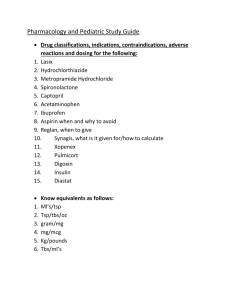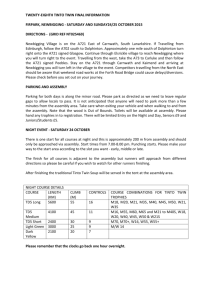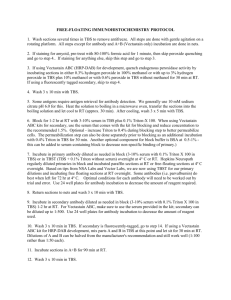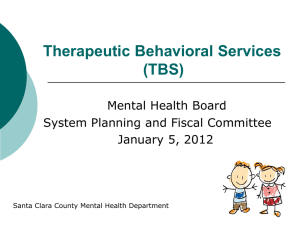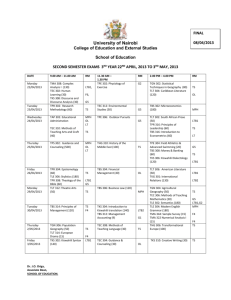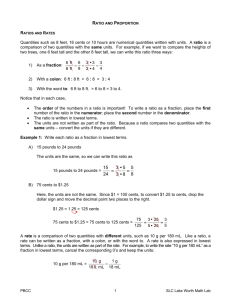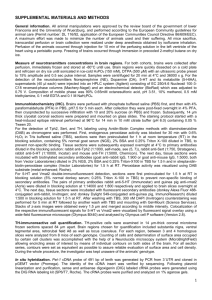Fruits - Blackberry, Strawberry, and Blueb
advertisement
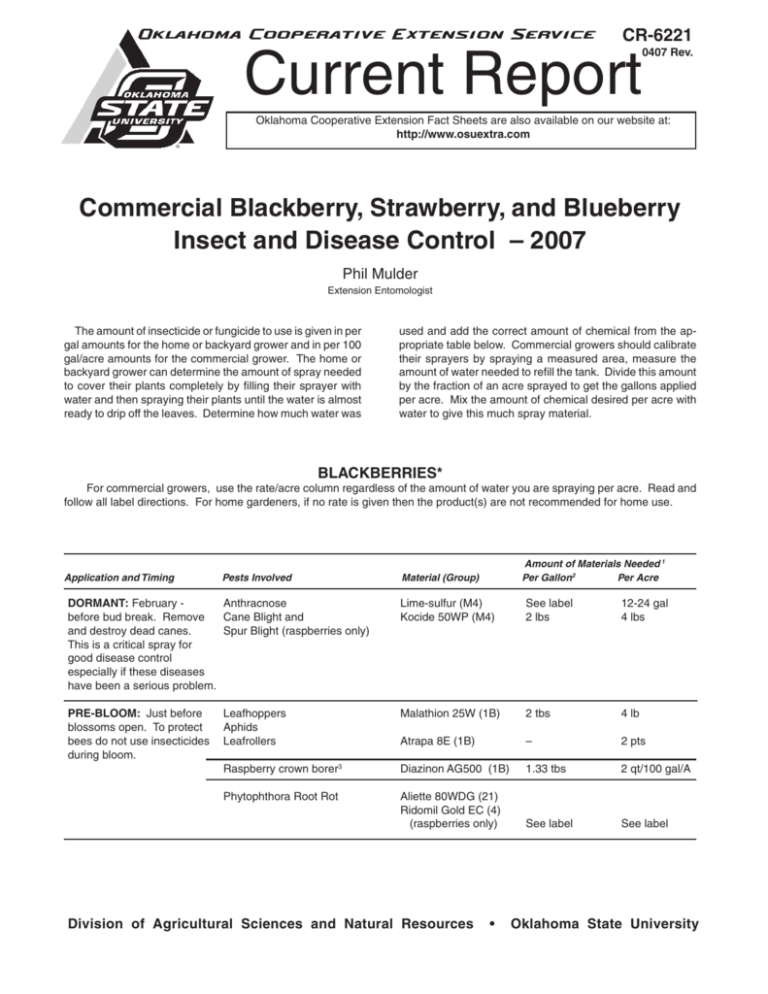
Oklahoma Cooperative Extension Service CR-6221 Current Report 0407 Rev. Oklahoma Cooperative Extension Fact Sheets are also available on our website at: http://www.osuextra.com Commercial Blackberry, Strawberry, and Blueberry Insect and Disease Control – 2007 Phil Mulder Extension Entomologist The amount of insecticide or fungicide to use is given in per gal amounts for the home or backyard grower and in per 100 gal/acre amounts for the commercial grower. The home or backyard grower can determine the amount of spray needed to cover their plants completely by filling their sprayer with water and then spraying their plants until the water is almost ready to drip off the leaves. Determine how much water was used and add the correct amount of chemical from the appropriate table below. Commercial growers should calibrate their sprayers by spraying a measured area, measure the amount of water needed to refill the tank. Divide this amount by the fraction of an acre sprayed to get the gallons applied per acre. Mix the amount of chemical desired per acre with water to give this much spray material. BLACKBERRIES* For commercial growers, use the rate/acre column regardless of the amount of water you are spraying per acre. Read and follow all label directions. For home gardeners, if no rate is given then the product(s) are not recommended for home use. Application and Timing Pests Involved DORMANT: February - Anthracnose before bud break. Remove Cane Blight and and destroy dead canes. Spur Blight (raspberries only) This is a critical spray for good disease control especially if these diseases have been a serious problem. Amount of Materials Needed 1 Material (Group) Per Gallon2 Per Acre Lime-sulfur (M4) Kocide 50WP (M4) See label 2 lbs 12-24 gal 4 lbs PRE-BLOOM: Just before Leafhoppers Malathion 25W (1B) 2 tbs 4 lb blossoms open. To protect Aphids bees do not use insecticides Leafrollers Atrapa 8E (1B) – 2 pts during bloom. Raspberry crown borer3 Diazinon AG500 (1B) 1.33 tbs 2 qt/100 gal/A Phytophthora Root Rot Aliette 80WDG (21) Ridomil Gold EC (4) (raspberries only) See label See label Division of Agricultural Sciences and Natural Resources • Oklahoma State University BLACKBERRIES (continued) Application and Timing Amount of Materials Needed 1 Material (Group) Per Gallon2 Per Acre Pests Involved Fungicide applications prior Anthracnose, Cane Abound (11) – 6.2-15.4 oz to bloom should not be Blight and Spur Cabrio (11) – 14 oz necessary unless these Blight (raspberries only) Pristine (11, 7) – 18.5-23 oz diseases have been a serious problem. Rusts, Powdery Mildew Nova 40W (3) 1.25-2.5 oz and Leaf Spots Captan 80 WDG (M4) 2.5 lb BLOOM THROUGH HARVEST Same as Pre-Bloom ANYTIME AFTER HARVEST (Sept. 15-Oct. 1) Cane Borers Remove and burn infested canes. Raspberry Crown Borer4 Capture 2ECr (3) – 6.4 oz Rusts, Powdery Mildew Nova 40WP (3) – 2.5 oz Restricted Use Pesticide 1 See Table 1 for date of last application prior to harvest. 2 tbs = tablespoon; lb = pound; gal = gallon. 3 Apply 2-4 qt/acre in a minimum of 100 gal of water as a drench to the crown area and lower canes. Drench will kill borers already hatched in soil. Not recommended for homeowners. 4 Raspberry Crown Borer is a significant pest of caneberries in Oklahoma and will eventually cause the demise of plants if left uncontrolled. Seasonal treatment each year is recommended. Capture applied in late October or early November as a soil drench to the lower canes and soil around the canes will provide excellent control if adequate (50 to 100 gallons/acre) water is applied with the material. This is a restricted use chemical, not recommended for homeowners. * All disease information and fungicide treatments are applicable to both blackberries and raspberries unless otherwise noted. Chemical classifications can be found at the following Web sites: Herbicides-http://www.plantprotection.org/hrac/; Insecticides-http://www.irac-online.org/; and Fungicides-http://www.frac.info/. r STRAWBERRIES Read and follow all label directions. For commercial growers, use the rate per acre column, regardless of the amount of water you are spraying per acre. For home gardeners, if no rate is given then the product is not recommended for home use. Application and Timing Amount of Materials Needed 1 Material (Group) Per Gallon2 Per Acre Pests Involved PRE-BLOOM: Just before Strawberry Root Weevil bloom (separation of blossom buds). Timing is important in controlling the strawberry weevil. To protect bees do not use insecticides during bloom. Phytophthora diseases BLOOM Botrytis Blossom Blight and Fruit Rot Malathion 25W (1B) or Sevin 50W (1A) or Malathion 57% EC (1B) Brigade WSBr (3) 4-6 tbs 2-4 tbs 0.66-0.2 tbs – 4-6 lb 2-4 lb 1.5-2.5 pt 8.0-32.0 oz Ridonil Gold EC (4) Aliette 80 WDG (21) Topsin M WSB (1) Elevate 50WG (17) Switch (9) Captan 50WP (M4) – – – – – – 1 pt 2.5-5 lb .75-1lb 1.5 lb 11-14 oz 6 lb Anthracnose Abound (11) Cabrio (11) Pristine (11,7) Switch (9) Captan 50WP (M4) – – – – – 6.2-15.4 oz 14 oz 18.5-23 oz 11-14 oz 6 lb Leaf Spots Nova 40W (3) Cabrio (11) Pristine (11, 7) Topsin M WSB (1) – – – – 2.5-5 oz 14 oz 18.5-23 oz .75-1 lb 6221.2 STRAWBERRIES (continued) Application and Timing Amount of Materials Needed 1 Material (Group) Per Gallon2 Per Acre Pests Involved Powdery Mildew POST BLOOM: After the Aphids blossoms have fallen. Leafrollers Spittlebugs Sowbugs Lygus Bugs Mites Leaf Diseases, Anthracnose, Powdery Mildew, and Fruit Rot Abound (11) Cabrio (11) Pristine (11, 7) Nova 40W (3) Procure 50WS (3) Topsin M WSB (1) Brigade WSBr (1) Lannate LVr (1A) Malathion 25W (1B) or Malathion 57% EC (1B) Pasada 1.6F (4A) Thionex (2A) Atrapa 8E (1B) Danitol 2.4EC (3) Javelin (B.t.) (11B2) – – – – – – – – 2.5 tbs 0.66 tbs – – – – 0.24-1.4 tsp 6.2-15.4 oz 14 oz 18.5-23 oz 2.5-5 oz 4-8 oz .75-1 lb 8.0-32.0 oz 1.5-3.0 pts 2.5 lb 1.5 pts 3.75 oz 1.3 qt 2 pts 10.66 oz 0.5-4.0 lbs Malathion 25W (1B) or 4-6 tbs 4-6 lb Sevin 50W (1A) or 2-4 tbs 2-4 lb Malathion 57% EC (1B) 0.66-1.5 tbs 1.5-2.5 pts Brigade WSBr (3) – 8.0-32.0 oz Danitol 2.4EC (3) – 16.0-21.33 oz Malathion 25W (1B) or 4-6 tbs 4-6 lb Malathion 57% EC (1B) 0.66-1.5 tbs 1.5-2.5 pts Abacusr (6) – 16.0 oz Acramite 50WS (25) – 0.75-1.0 lb Atrapa 8E (1B) – 2 pts Agri-mek 0.15 EC (6) – 16 fl oz Brigade WSBr (3) – 16.0-32.0 oz Danitol 2.4EC (3) – 16.0-21.33 oz Dicofol 4E (20) – 2 pts Kelthane 35WP (20) or 0.5 tbs 0.9 lb Kelthane MF (20) 1 tsp 2 pts Vendex 50WP (12B) – 1.5-2 lb Zeal (10B) – 2-3 oz Same as Bloom. Subsequent applications may be necessary. Check label for recommendations and restrictions near harvest. See Table 1 for date of last application prior to harvest. If no number is provided then that chemical cannot be used on that crop tbs = tablespoon; tsp = teaspoon; pt = pint; qt = quart; lb = pound; gal = gallon. 3 Nova is highly effective for control of powdery mildew and leaf blight. Captan and Thiram will not control powdery mildew. 1 2 Chemical classifications can be found at the following Web sites: Herbicides-http://www.plantprotection.org/hrac/; Insecticides-http://www.irac-online.org/; and Fungicideshttp://www.frac.info/. BLUEBERRIES For commercial growers, use the rate/acre column regardless of the amount of water you are spraying per acre. Read and follow all label directions. For home gardeners, if no rate is given, then the product is not recommended for home use. Application and Timing Amount of Materials Needed 1 Material (Group) Per Gallon2 Per Acre Pests Involved DELAYED DORMANT: Scale insects Superior Oil or 4 tbs 3 gal Just before bud break Lime sulfur (M4) 7 tbs 5 gal Phomopsis Twig Blight Lime sulfur (M4) 7 tbs 5 gal Phytophthora Root Rot Ridomil Gold EC (4) – 3.6 pt Aliette 80WDG (21) – 5 lb 6221.3 BLUEBERRIES (continued) Application and Timing Amount of Materials Needed 1 Material (Group) Per Gallon2 Per Acre Pests Involved PRE-BLOOM: Just before Leafrollers Javelin (B.t.) (11B2) 0.12-0.5 tsp 0.5-4.0 lb blossoms open Sevin 50W (1A) 2-4 tbs 2-4 lb Blossom Weevil Sevin 50W (1A) 2-4 tbs 2-4 lb Phomopsis Twig Blight and Ziram (76DF, Granuflo) 2 tbs 3lb Mummy Blight (shoot phase) (M4) MID-BLOOM: Do not use Leafrollers Dipel, Javelin or 2 tsp 2 qt chemical insecticides Thuricide (11B2) 1.5 tsp 1 lb during bloom. Phomopsis Twig Blight, Abound (11) – 6.2-15.4 oz Anthracnose and Mummy Blight Cabrio (11) – 14 oz Pristine (11, 7) – 18.5-23 oz Switch (9) – 11-14 oz Ziram (76DF, Granuflo) 2 tbs 3 lb (M4) Anthracnose and Mummy Blight Captan – (50W, 80WDG, 4L) (M4) See label. FIRST POST- Leafrollers Javelin (B.t.) (11B2) 0.12-0.5 tsp 0.5-4.0 lb POLLINATION: Leafhoppers (Leafrollers only) (about May 25 to June 1) Leaf Miners Lannate LVr (1A) 1 tsp 1.5-3 pt Cherry Fruitworm Sevin XLR Plus (1A) 1 tbs 1.5-2 qt Aphids Atrapa 8E (1B) – 2 pts Plum Curculio Phomopsis Twig Blight Same as Mid-Bloom Spray. Anthracnose, and Mummy Berry SECOND POST- Leafrollers Same as First Post-Pollination Spray. POLLINATION: Leafhoppers 7-12 days after First Leaf Miners Post-Pollination Spray Cherry Fruitworm Phomopsis Twig Blight Same as First Post-Pollination Spray and Blight, Anthracnose ADDITIONAL COVER Leafrollers SPRAYS: Apply every Leaf Miners Javelin (B.t.) (11B2) 0.12-0.5 tsp 0.5-4.0 lb 7-12 days as needed. Fall Webworms (Not for Leaf Miners or Leafhoppers) MAGGOTS: When flies Blueberry Maggot Malathion 25WP (1B) 2 tbs 4 lb start to lay eggs (about Sevin XLR Plus (1A) 1 tbs 1.5-2 qt June 28). Repeat every Lannate LV (1A) – .75-1.5 pts 10 days through harvest. POST-HARVEST: When 2/3 leaves have dropped. Repeat after 14 days. Phomopsis Twig Blight Lime sulfur (M4) 7 tbs 5 gal Restricted Use Pesticide. 1 See Table 1 for date of last application prior to harvest. 2 tbs = tablespoon; tsp = teaspoon; pt = pint; qt = quart; gal = gallon; lb = pound. r Chemical classifications can be found at the following Web sites: Herbicides-http://www.plantprotection.org/hrac/; Insecticides-http://www.irac-online.org/; and Fungicideshttp://www.frac.info/. 6221.4 Table 1. Days Waiting Time — Last Application Before Harvest. Number of Days Before Harvest CHEMICAL BLACKBERRIES STRAWBERRIES BLUEBERRIES Abacusr Abound Acramite Agri-mek 0.15 EC Aliette 80 WDG Atrapa 8E Brigade WSB B.t. (Dipel, Javelin, Thuricide) Cabrio Captan Dicofol 4E Elevate 50WG Imidan 50WP or 70WP Javelin Kelthane Lannate LVr Lorsban 4Er Malathion Nova 40W Pasada Pristine Procure 50WS Ridomil Gold EC Sevin Switch Thionex Topsin M WSB Vendex 50WPr Zeal Ziram – 0 — – 60 1 0 0 0 0 – 0 – 0 – – – – 1 0 – 0 1 60 (raspberries only) 7 0 – 1 – – – 3 0 1 3 0 3 0 0 0 0 2 0 – 0 2 3 (Fresh) 10 (Processing) 21 3 0 7 0 1 – – 0 1 1 4 1 – Restricted Use Pesticide. r 6221.5 – 0 — – 0 1 – 0 0 0 – – – 0 – 3 – – 1 – – 0 – – – 0 – – – – 14 CULTURAL CONTROL METHODS With more chemicals being removed from the market, growers must have successful ways of controlling disease and insects through cultural means. Disease and insects may be controlled or the effects of these pests can be reduced using cultural methods. The methods to consider are site selection, maintaining good soil conditions, sanitation, and purchase of healthy, and where available, resistant varieties. A well chosen site includes good air drainage to reduce spring frost damage, circulation, and adequate soil water drainage. Sites with these qualities improve plant growth and decrease plant susceptibility to insects and disease. Orienting rows for good sun exposure and natural air movement will dry leaves and fruit quickly. Raised beds improve soil drainage and reduce infections by root diseases. Proper site selection to decrease plant stresses, such as cold injury and buffeting by winds, can reduce attack by insects and diseases. New plantings located near old established areas may have greater risks of insect and disease populations from the old sites than plantings on isolated areas. Destroying native plant species in the immediate area that harbor harmful insects or diseases can reduce pest problems. An important disease and insect control procedure is the planting of adapted, healthy, disease and insect resistant varieties. Plants should be purchased from reliable sources, and only healthy looking stock planted. Variety selection should be based on adaptation to the area, such as cold hardiness, heat tolerance, adaptation to soils, and ability to produce acceptable yields of high quality fruit. Varieties will vary in the degree of susceptibility to an insect or disease. The nursery, supplier or county educator should have a recent list of adaptive and resistant cultivars that are available for planting in Oklahoma. Maintaining proper soil moisture and fertilization can ensure healthy plants. These plants will be more resistant to disease and insect damage than plants over or under fertilized or watered. Annual leaf analysis and soil analysis can be used to determine fertilization rates. Rainfall and soil moisture should be monitored to determine when to irrigate plants. Tensiometers, watermarks or some other form of measuring soil moisture may be used to determine when irrigation is necessary in larger plantings. This may not be necessary in smaller plantings where rainfall and stress of plants can be monitored directly. Sanitation is important in controlling some insects, and especially in controlling diseases. Diseased and dead branches should be removed and when necessary, entire plants should be removed to reduce overwintering sites for insects and pathogens. These infected materials should be burned or removed from the site. Unharvested fruit, leaf litter and prunings should be removed to decrease the spread and population increase of insects and diseases. Pruning equipment should be disinfected before, during and after use to avoid transmitting disease during pruning. A solution of 10 percent chlorine bleach and 90 percent water is a good disinfectant. Weed control is essential for plant growth and production. Economic losses due to weeds are sometimes greater than those caused by insects or diseases. Weeds compete 6221.6 directly with crops for nutrients, water and light and serve as hosts for insects and diseases. Weeds may also interfere with pesticide application, harvesting and air circulation in planting. To control weeds, an integrated program using cultural practices (such as pulling or hoeing weeds) along with herbicides is the most effective. Suitable herbicides for weed control in small fruit plantings are listed in Extension Fact Sheet F-6243, “Weed Control in Small Fruit Crops.” The above cultural practices along with timely applications of pesticides will produce high quality fruit. It is usually necessary to use each of these cultural methods along with pesticides to attain good control leading to healthier plants, higher quality fruit and greater yields. Following is a list of specific cultural methods for controlling various insects and diseases in blueberry, strawberry and blackberry production. These methods can be used alone or in conjunction with insecticides and fungicides to limit the spread of insects and diseases. BLUEBERRY Red and necrotic ringspot and blueberry stunt Plant disease-free stock. Remove and burn diseased plants. Control insects which may be vectors of disease. Phytophthora root rot Limit movement of soil and water to lessen disease damage. Anthracnose No cultural method of control. Botrytis, blossom and fruit rots Ensure good air circulation and sun exposure to quickly dry wet leaves. Phomopsis twig and cane blight Prune and burn diseased wood. Stem canker (various fungi) Purchase disease-free stock. Purchase resistant varieties. Remove dead and dying branches 6 to 8 inches below diseased wood. Climbing cutworm Hand pick off of blossom when they become numerous enough to warrant control. Blueberry bud mite Selectively prune out old canes to reduce populations. Choose non-susceptible varieties. Fall webworm Destroy webs by hand. STRAWBERRY Leaf scorch Frequent renewal of plantings. Purchase resistant varieties. Strawberry weevil Use the same bed less than three years. Plow under old beds immediately after harvest. Renovate existing beds by mowing or removing foliage and mulch. Anthracnose Remove plant debris and mulch. Purchase resistant varieties, where available. Use only enough fertilizer to establish plants, but do not over fertilize them. If any signs of anthracnose occur, discontinue all applications of nitrogen and potassium. Mites Purchase mite-free stock. Isolate new plantings from established plantings. Make sure plants are healthy and well-watered. Use a water hose to wash mites from plants. BLACKBERRY Lygus bugs Control weeds in and near planting to reduce host plants from insects and disease. Anthracnose Remove and burn old canes. Cane boreres Remove and burn infested canes. Weeds or alfalfa that have been growing should not be removed during the strawberry blossom period, because the insects will move into the strawberries. Publications that may be helpful: Leaf spot Plant disease-free stock. F-6213, Weed Management in Small Fruit Crops F-6214, Growing Strawberries in the Home Garden F-7612, Plant Disease Diagnostic Service F-6239, Commercial Blackberry Production F-6215, Home Culture of Blackberries Powdery mildew Kill or burn leaves which mycelia are on. Purchase resistant varieties. 6221.7 The Oklahoma Cooperative Extension Service Bringing the University to You! The Cooperative Extension Service is the largest, most successful informal educational organization in the world. It is a nationwide system funded and guided by a partnership of federal, state, and local governments that delivers information to help people help themselves through the land-grant university system. Extension carries out programs in the broad categories of agriculture, natural resources and environment; family and consumer sciences; 4-H and other youth; and community resource development. Extension staff members live and work among the people they serve to help stimulate and educate Americans to plan ahead and cope with their problems. Some characteristics of the Cooperative Extension system are: • The federal, state, and local governments cooperatively share in its financial support and program direction. • • It is administered by the land-grant university as designated by the state legislature through an Extension director. • It provides practical, problem-oriented education for people of all ages. It is designated to take the knowledge of the university to those persons who do not or cannot participate in the formal classroom instruction of the university. • It utilizes research from university, government, and other sources to help people make their own decisions. • More than a million volunteers help multiply the impact of the Extension professional staff. • It dispenses no funds to the public. • It is not a regulatory agency, but it does inform people of regulations and of their options in meeting them. • Local programs are developed and carried out in full recognition of national problems and goals. • The Extension staff educates people through personal contacts, meetings, demonstrations, and the mass media. • Extension has the built-in flexibility to adjust its programs and subject matter to meet new needs. Activities shift from year to year as citizen groups and Extension workers close to the problems advise changes. Extension programs are nonpolitical, objective, and research-based information. Oklahoma State University, in compliance with Title VI and VII of the Civil Rights Act of 1964, Executive Order 11246 as amended, Title IX of the Education Amendments of 1972, Americans with Disabilities Act of 1990, and other federal laws and regulations, does not discriminate on the basis of race, color, national origin, gender, age, religion, disability, or status as a veteran in any of its policies, practices, or procedures. This includes but is not limited to admissions, employment, financial aid, and educational services. Issued in furtherance of Cooperative Extension work, acts of May 8 and June 30, 1914, in cooperation with the U.S. Department of Agriculture, Robert E. Whitson, Director of Cooperative Extension Service, Oklahoma State University, Stillwater, Oklahoma. This publication is printed and issued by Oklahoma State University as authorized by the Vice President, Dean, and Director of the Division of Agricultural Sciences and Natural Resources and has been prepared and distributed at a cost of 42 cents per copy. 0407 GH 6221.8
